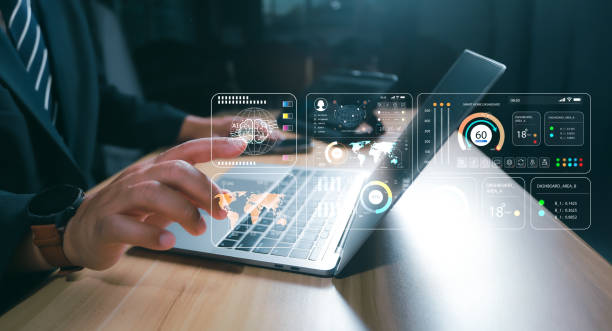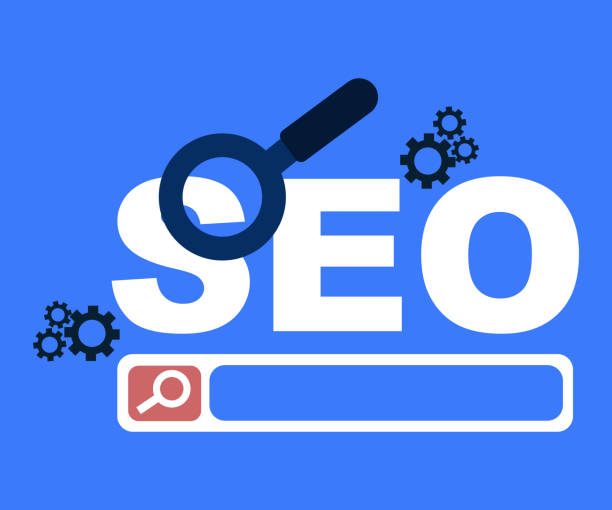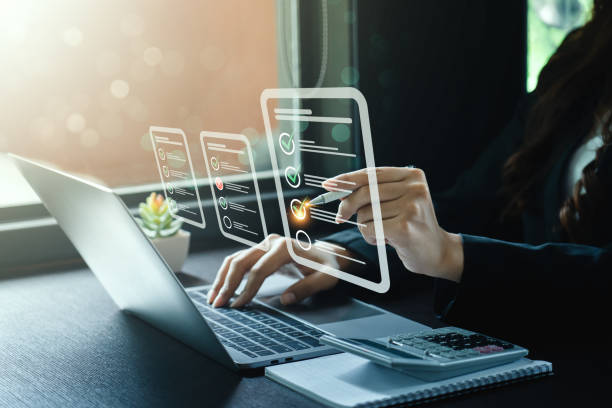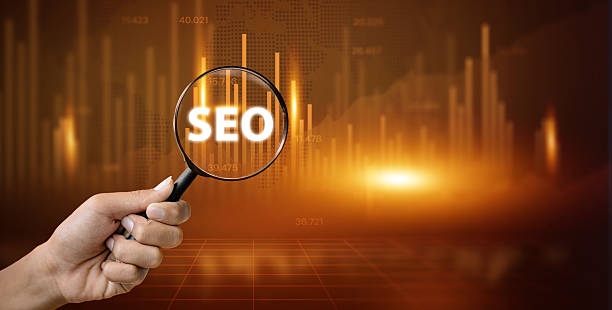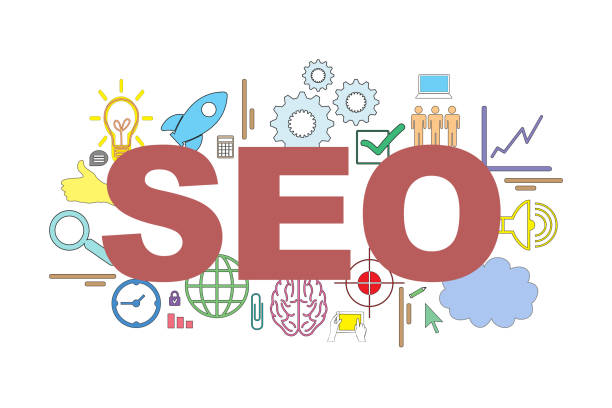Understanding On-Page SEO: Why is it Important?
In today’s highly competitive web world, effective online presence is not achieved merely by having a beautiful website; it requires more complex strategies.
One of the most important of these strategies is #On-Page_SEO or internal optimization.
On-page SEO refers to a set of actions performed within your website to improve its ranking in search engine results.
These actions include optimizing content, site structure, HTML codes, and other internal elements that help search engines better understand your pages and display them to appropriate users.
The importance of on-page SEO goes beyond achieving rankings; it directly impacts user experience as well.
A website that is well-optimized for on-page SEO is not only more understandable for Google bots but also offers easier navigation and more relevant content to visitors.
In fact, on-page SEO is considered a solid foundation for any successful SEO strategy.
Without it, even the strongest backlinks cannot bring your website to the top.
In this section, we will provide a comprehensive and educational explanation of what on-page SEO is and why it’s important, and show how this approach can significantly increase your organic traffic.
From URL structure to the correct use of heading tags, all important details for improving site ranking in search engines will be examined.
This process is a long-term investment that brings sustainable and positive results for your business.
Does your current e-commerce website design lead to losing customers and sales?
Rasawb is your solution with modern and user-friendly e-commerce website designs!
✅ Significant increase in conversion rates and sales
✅ Creation of strong branding and building customer trust
⚡ Get a free e-commerce website design consultation from Rasawb!
Keyword Research for On-Page SEO: The Cornerstone of Success
Keyword research is the backbone of any successful SEO strategy, and this holds true for on-page SEO as well.
Before you even write a single line of content or design a page, you need to know what your users are looking for and what phrases they use to search for it.
Keyword research involves identifying the phrases and terms your target audience enters into search engines to find information, products, or services related to your business.
This step is a vital guide for determining your content strategy.
From “short-tail” and competitive keywords like “SEO” to “long-tail” and more specific phrases like “best on-page SEO tools for WordPress,” each plays a different role in attracting traffic.
To do this, various tools such as Google Keyword Planner, Ahrefs, Semrush, and Moz Keyword Explorer are available to help you examine search volume, competition levels, and the relevance of various keywords.
A specialized approach to keyword research involves analyzing Search Intent; that is, understanding what type of information users are truly seeking when they search for a particular keyword.
Are they intending to buy (commercial), want to learn something (informational), or are they looking for a specific website (navigational)? Correct keyword selection and their natural integration into the site’s content are a crucial part of on-page SEO optimization that sends stronger signals to search engines and helps your pages appear in more relevant results.
Optimizing Title Tag and Meta Description: First Encounter with the User
The Title Tag and Meta Description are the first impressions users and search engines have of your page. These two small but powerful elements play a vital role in on-page SEO and your Click-Through Rate (CTR).
The Title Tag is the text displayed in the browser’s top bar and as the main title in search results.
It should contain the page’s main keywords, be appealing and concise (usually between 50 to 60 characters), and encourage users to click.
Writing a strong Title Tag requires a combination of precise analysis and creativity to be both optimized for search engines and attractive to users.
The Meta Description is a short summary (about 150-160 characters) of the page’s content that appears below the Title Tag in search results.
Although it does not directly impact ranking, it increases CTR by encouraging users to click, which is itself a positive signal for Google.
It should include relevant keywords and have a Call to Action.
To help with better understanding, we provide a practical tutorial in the table below, illustrating the difference and importance of these two elements:
| On-Page SEO Element | Description | Importance for On-Page SEO |
|---|---|---|
| Title Tag | Clickable text in search results and browser tab | Most important On-page signal for search engines, direct impact on CTR. |
| Meta Description | Short summary below the title in search results | Indirect impact on ranking by increasing CTR. |
Proper optimization of these elements is an essential step in your on-page SEO strategy and not only helps search engines better understand your content but also encourages users to click on your link.
The higher the CTR, the better the signal sent to Google that your content is relevant and useful.
Click here to preview your posts with PRO themes ››
URL Structure and Its Importance in On-Page SEO
An optimized and meaningful URL structure is a vital element in on-page SEO that is often overlooked. The URL or web address of each page is not only the access point to your content but can also help search engines and users quickly understand the site’s structure and page topic.
A good URL should be short, readable, and include the page’s main keywords.
For example, instead of “yoursite.com/?p=123”, using “yoursite.com/blog/on-page-seo-guide” is much better.
This approach provides a clear explanation of the page’s content to search engines and helps them understand the information hierarchy.
Clean and structured URLs are not only beneficial for on-page SEO but also improve user experience.
When users see a meaningful URL, they can guess what the page’s content is about before clicking, which increases trust and reduces bounce rate.
Using hyphens (-) instead of underscores (_) to separate words and avoiding special characters, as well as steering clear of stopwords like “and”, “or”, “from” in the URL (unless absolutely necessary in specific cases) are other points to observe.
Designing a logical URL structure, especially for large sites with a lot of content, is crucial to prevent duplicate pages and improve search engine crawling.
A hierarchical URL structure that reflects your site’s categorization helps search engines understand the relationships between different pages and properly distribute Link Equity.
Losing potential customers due to an unprofessional website? Rasawb is your answer! With our specialized corporate website design services:
✅ Enhance your business’s credibility and standing
✅ Experience more targeted customer acquisition
⚡ Act now to receive a free website design consultation!
Content Optimization and Heading Usage: The Heart of On-Page SEO
Content is king, and in the realm of on-page SEO, this phrase rings truer than ever. But merely having content is not enough; it must be quality, relevant, and optimized for both search engines and users.
Content optimization goes beyond just stuffing it with keywords.
It involves creating deep and comprehensive content that answers user questions and meets their needs.
Your content should be thought-provoking content to encourage users to interact and stay on the page.
Using main keywords and their synonyms naturally within the text, not forcibly (Keyword Stuffing), is very important.
In addition to quality and relevance, structuring content using headings (H1, H2, H3, and so on) is of high importance.
H1 is your page’s main title and should contain the primary keyword.
H2s are used for main subheadings, and H3s for further sub-subheadings.
This hierarchy not only improves content readability for users but also helps search engines understand the structure and subtopics of your content.
A logical and specialized heading structure signals to search engines that your content is well-organized and easy to understand.
Also, using short paragraphs, lists, quotes, and relevant images can improve the reading experience and engage users more.
Continuous content optimization based on user feedback and Google’s algorithm changes is an inseparable part of the on-page SEO strategy.
Image Optimization for On-Page SEO: Search Engine Visual Perception
Images play a vital role in a website’s visual appeal and user experience, but if not properly optimized, they can slow down site speed and harm on-page SEO.
Image optimization for on-page SEO involves several key steps that help search engines understand your images and rank them in image search results.
The first step is using descriptive, keyword-rich file names.
For example, instead of “IMG001.jpg”, use “on-page-seo-guide.jpg”.
This is a simple but effective guide.
Second, using Alt text (alternative text).
Alt text is the text displayed if an image fails to load and is also read by screen readers for visually impaired users.
It should be concise, descriptive, and include relevant keywords.
This helps search engines understand the image content.
Third, compressing images.
High-volume images can severely slow down page loading speed, which is a negative factor in ranking and user experience.
Using image compression tools and choosing appropriate formats (like WebP) can significantly reduce file sizes without losing quality.
Image dimensions are also important; ensure that images are uploaded with appropriate dimensions and do not require resizing by the browser.
Image optimization is an inseparable part of a website’s on-page SEO strategy and can help improve site speed, gain rankings in image search, and ultimately increase organic traffic.
Internal Linking and Its Value: The Information Spiderweb
Internal Linking is the process of creating links from one page to another within the same website. This is one of your most powerful, yet often overlooked, tools in on-page SEO.
Internal links serve several important purposes: First, they help search engines understand your site’s structure and discover different pages.
Second, they distribute power and authority (Link Equity) throughout your website.
When a strong page links to another page, it passes some of its “authority” to that page.
Third, they improve user experience and help users easily navigate your site and find relevant content, which can increase time spent on site.
For بهرهبرداری حداکثری از internal linking, you should use descriptive and relevant anchor texts.
Instead of “click here”, use phrases like “comprehensive on-page SEO guide”.
Precise analysis of site structure and content can help you identify the best places to put internal links.
One effective strategy is “silooing” structure, where pages related to a specific topic are linked to each other to create a strong authority in that field.
Below is a news-like table of the benefits of internal linking:
Click here to preview your posts with PRO themes ››
| Benefit of Internal Linking | Explanation |
|---|---|
| Improved Search Engine Crawling | Google bots find and index your pages more easily. |
| Link Equity Distribution | Authority (PageRank) is passed from stronger pages to other internal pages. |
| Improved User Experience (UX) | Easier navigation and discovery of relevant content for users. |
| Increased Time on Site | Users spend more time on the site by finding relevant content. |
| Reduced Bounce Rate | Users are redirected to other internal pages instead of leaving the site. |
Internal linking is a crucial component for any successful on-page SEO strategy that helps you gain more control over how search engines understand your website and ultimately achieve higher rankings.
Site Speed and Core Web Vitals: Key Factors in On-Page SEO
Site loading speed has long been recognized as a ranking factor for Google, but with the introduction of Core Web Vitals in 2021, its importance significantly increased.
Core Web Vitals are a set of user experience metrics introduced by Google and include three main metrics: Largest Contentful Paint (LCP), First Input Delay (FID), and Cumulative Layout Shift (CLS).
LCP refers to the loading speed of the largest content element on the page; FID measures the site’s responsiveness to the first user interaction; and CLS evaluates the visual stability of the page (preventing sudden layout shifts).
Optimizing these metrics is a specialized aspect of on-page SEO and has a direct impact on ranking and user experience.
A site that loads quickly and provides a smooth user experience is not only rewarded by Google but also keeps users satisfied and increases conversion rates.
Numerous factors affect site speed, including the size of images and videos, JavaScript and CSS codes, hosting type, and the use of a Content Delivery Network (CDN).
To improve these factors, you should focus on resource compression, server-side code optimization, database optimization, and caching.
Continuous analysis of site performance with tools like Google PageSpeed Insights and Google Search Console to identify weaknesses and continuously improve site speed is one of the important principles of on-page SEO.
Did you know that 94% of users’ first impressions of a business relate to its website design? With professional corporate website design by **Rasawb**, turn this first impression into an opportunity for growth.
✅ Attract more customers and increase sales
✅ Build credibility and trust in the audience’s eyes⚡ Get a free website design consultation now!
Schema Markup and Rich Snippets: Rich Display in Search Results
Schema Markup (Schema Markup) is code added to your website that helps search engines understand your content more deeply. It is a powerful but often overlooked component of on-page SEO.
While search engines can crawl and index your text and images, schema gives them more context and meaning.
For example, if you have a recipe on your website, schema can tell Google that this text is a “recipe” and includes information like ingredients, cooking time, and user ratings.
This additional information can then appear as “Rich Snippets” in search results, which include rating stars, small images, or other details.
Rich Snippets make your link stand out more prominently in search results and significantly increase the Click-Through Rate (CTR).
There are various types of schema, including schema for products, events, articles, FAQs, organizations, and people.
Using schema provides supplementary explanation to Google and enables it to display more precise information to users.
Implementing schema can be somewhat fun, especially when you see how your site transforms in search results.
Tools like Google’s Structured Data Testing Tool help you validate schema codes.
Although schema is not directly a ranking factor, the increase in CTR due to Rich Snippets indirectly helps improve your on-page SEO and visibility in search results.
Internal SEO Analysis and Monitoring: Next Steps and Continuous Improvement
On-page SEO is not a one-time process; it requires continuous analysis and monitoring. The world of SEO is constantly changing, and search engine algorithms are regularly updated.
To maintain and improve your site’s ranking, you must continuously monitor your on-page SEO performance and adjust your strategies accordingly.
Various tools are available for this purpose, each offering diverse analytical and educational capabilities.
Google Search Console (GSC) is a free and essential tool that provides valuable information about how Google views your site, the keywords you rank for, crawling issues, and Core Web Vitals status.
Google Analytics is also vital for monitoring traffic, user behavior, bounce rate, and other user interaction metrics.
Paid tools like Ahrefs, Semrush, and Moz also provide more advanced features for keyword monitoring, competitor analysis, backlink checks, and site SEO health.
Continuous monitoring helps you quickly identify and fix technical on-page SEO issues, find new opportunities to improve content and site structure, and stay ahead of your competitors.
Additionally, always seek new education and learn the latest techniques and best practices in the field of SEO.
Challenges in on-page SEO are many, but with careful data analysis and smart changes, you can continuously improve your site’s performance and solidify its position in search results.
This continuous improvement cycle guarantees long-term success in the digital space.
Click here to preview your posts with PRO themes ››
Frequently Asked Questions
| Row | Question | Answer |
|---|---|---|
| 1 | What is On-Page SEO? | On-page SEO refers to a set of actions performed within a website (on its pages) to improve its ranking in search engine results. This includes optimizing content, site structure, and HTML codes. |
| 2 | Why is On-Page SEO important? | On-page SEO helps search engines better understand page content and determine whether that page is relevant and valuable for user searches. This better understanding leads to higher rankings. |
| 3 | What is the first and most important step in On-Page SEO? | Keyword Research is the most important initial step. By finding appropriate keywords, targeted content relevant to user needs can be produced. |
| 4 | What is the role of the Title Tag in On-Page SEO? | The Title Tag is one of the most important ranking factors and should include the main keyword. This tag is displayed as the page title in search results and influences the Click-Through Rate (CTR). |
| 5 | What is the importance of Meta Description? | The Meta Description does not directly affect ranking, but by providing an attractive summary of the page content in search results, it can encourage users to click, thereby increasing the Click-Through Rate (CTR). |
| 6 | Why is using headings (H1, H2, etc.) in content important? | Headings help structure content and improve readability for users and search engine crawlers. Using keywords in headings also helps the search engine better understand the topic. |
| 7 | What does Image Optimization in On-Page SEO include? | It includes compressing images to reduce size, using descriptive and relevant file names, and filling the Alt tag (alternative text) with relevant keywords to help search engines understand the image content. |
| 8 | What is meant by Internal Linking in On-Page SEO? | Internal linking refers to creating links between different pages of a website. This helps distribute page authority (Link Equity), improve user experience, and assist search engine crawlers in discovering new pages. |
| 9 | Why is Page Speed important for On-Page SEO? | Page loading speed is a direct ranking factor and significantly impacts user experience. Slow pages can lead to an increased Bounce Rate and reduced user engagement. |
| 10 | What role does quality content play in On-Page SEO? | Quality, comprehensive, unique, and valuable content for the user, is the core of on-page SEO. This content not only attracts and retains users but also sends positive signals to search engines, helping achieve better rankings. |
And other services of Rasa Web Advertising Agency in the field of advertising
Smart Data Analysis: Professional optimization for campaign management using attractive UI design.
Smart Content Strategy: Professional optimization for customer behavior analysis using user experience customization.
Smart Link Building: An effective tool for user interaction through user experience customization.
Smart Conversion Rate Optimization: A specialized service for customer acquisition growth based on user experience customization.
Smart Google Ads: An effective tool for user interaction through Google ad management.
And over hundreds of other services in the field of internet advertising, advertising consultation, and organizational solutions
Internet Advertising | Advertising Strategy | Advertorials
Sources
Mozilla On-Page SEO Guide
What is On-Page SEO? Mizbanfa
Comprehensive On-Page SEO Guide – Webramz
On-Page SEO Checklist – Pardazit
? Are you ready for your business to shine in the digital world? Rasaweb Afarin Digital Marketing Agency, by offering comprehensive solutions including fast website design and professional SEO and content marketing, helps you achieve your goals. Experience a powerful and impactful online presence with us.
📍 Tehran, Mirdamad Street, next to Central Bank, Southern Kazeroun Alley, Ramin Alley, No. 6


